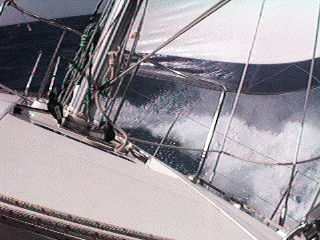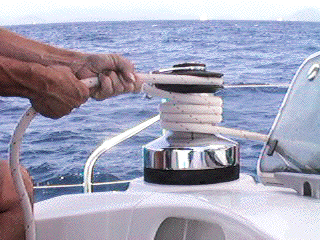|



| |
What's so great about sailing anyway?

Warning: never trust a zealot for they have been blinded by enthusiasm.
OK, OK, so I think sailing is great. Granted it isn't for everyone, but here's what I
think is great about it:
Intellectual Challenge
Sailing provides me with just the right amount of intellectual distraction for a
vacation. I'm the type of person who loves to sit on a beach, but after a day or two of
that, my mind starts to wander. There is plenty to think about when you are sailing. There
is always a sail to trim or a line to adjust. On the other hand, if you don't do anything,
you will probably still get to your destination, you'll just get there a little slower. If
you feel lazy, don't worry about it. If you start to think about work or some other silly
thing, feel free to tinker yourself to distraction.
Physical Challenge

Isn't Sailing a lot of work? Lots of people ask me this. I never quite know what to
answer. Some people see what we have to go through and say, "Wow, that's a lot of
work!" Somehow, I never really noticed that. Maybe I'm biased, so the best I can do
is tell you what we have to do that requires more exertion than our daily desk job
routines at home. You be the judge.
 | Every morning I check the diesel engine for oil & coolant. This requires lifting the
stairs in the companionway (20 lbs?), checking the dipstick, then putting the stairs back.
I've never had to add anything to a Moorings boat, but I check anyway.
|
 | Climbing up on deck is a little strenuous. It is basically four stairs that are a little
more like ladder rungs than stairs. This could be a problem for physically challenged
people.
|
 | Picking up the anchor - Any boat of any size that we've chartered has had a windlass to
lift the anchor for us. Its a few minutes worth of exercise for your toes to run the
windlass. Not really a problem.
|
 | Raising the sails - OK this is a good 60 seconds worth of workout. On a 45 foot boat,
you have 50+ feet of mast, and 950+ square feet of sail. Getting the sail up the last 5
feet of the mast is a bit of a job. With two people and a good self-tailing winch it isn't
too bad, and it doesn't last too long, but its more work than I usually have walking from
the parking lot to my office.
|
 | Tacking - I think this is what people think of when they think about the work of
sailing. In the BVIs there have been days where we sailed for several hours and tacked
only once in the entire day. When you are beating your way upwind you may have to tack a
bit more often. This usually entails 10 seconds worth of pulling on the jib sheet followed
by another ten seconds of grinding with the winch handle. If you really want to make this
a workout you can, but 20 seconds of exercise a few times a day is hardly an aerobic
workout.
|
 | Dropping the sails - This is more an exercise in agility than muscles. You have to
gather in the previously mentioned 950+ square feet of sail and tie it to the boom using
little ties that never quite seem to wrap around the boom the way you want them to. Its a
bit of a challenge to manage that much heavy sail fabric, but certainly not heavy
exercise.
|
 | Dropping Anchor - The anchor is heavy. It tends to go down. No real 'work' involved.
|
 | Lifting your drink - At this point it is good to convince yourself that you've done a
lot of work so that you think you deserve an exotic drink as you relax in the sun. Lifting
that glass can be a lot of work! |
Danger
I wont mislead you here. You can kill yourself sailing. You can also kill yourself
driving a car, but that doesn't stop people from jumping in the car on a moment's notice.
In general, people are more familiar driving than sailing, so they are more prepared for
unexpected events. Good training and familiarity can help you to be prepared for sailing
too. We took several classes and got our ASA bareboat certification just to make sure that
we knew the basics. You have to be alert for danger signs. Charters are particularly
vulnerable because they have an unfamiliar boat in unfamiliar waters and sometimes
questionable skills and inexperience.
With that said, a little common sense goes a long way. In popular cruising areas, there is
usually a lot of support for charterers. Hire a captain for the first couple of days to
help you ease into the leadership role. Depending on your sailing resume, the chartering
company may even require this. It can be good to have a captain aboard to show you the fun
places to go and the less obvious features of your boat.
The basics are pretty easy. Just remember Roger's chartering rules:
 | Don't run into a reef. |
 | Don't put your body between a high tension line and the place that line is going to want
to be when the tension changes. |
 | Navigate. |
 | Don't run the propeller when there are people or lines in the water. |
|